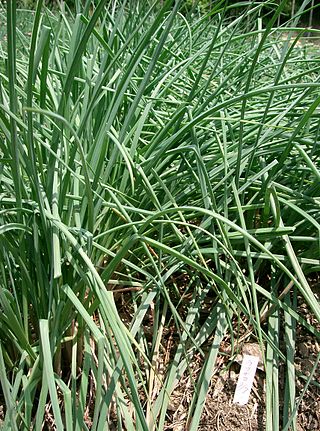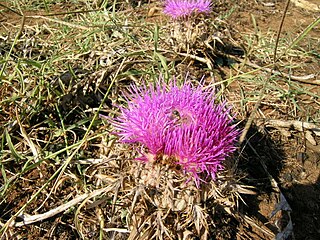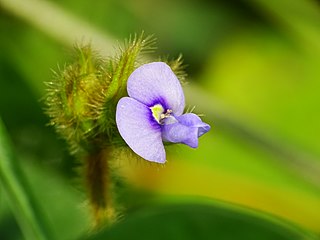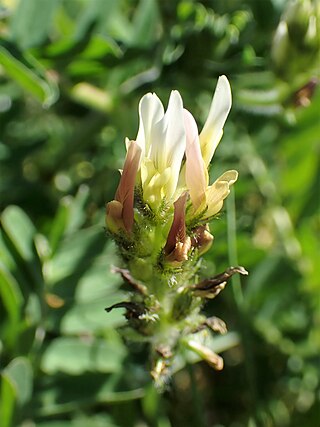
Canarium ovatum, the pili, is a species of tropical tree belonging to the genus Canarium. It is one of approximately 600 species in the family Burseraceae. C. ovatum are native to the Philippines. They are commercially cultivated in the Philippines for their edible nuts and is believed to be indigenous to that country. The fruit and tree are often vulgarized with the umbrella term of "Java almond" which mixes multiple species of the same genus, Canarium.
Plants For A Future (PFAF) is an online not for profit resource for those interested in edible and useful plants, with a focus on temperate regions. Named after the phrase "plans for a future" as wordplay, the organization's emphasis is on perennial plants.

Calycanthus floridus, or commonly known as the eastern sweetshrub, Carolina all spice, or spicebush, is a species of flowering shrub in the family Calycanthaceae. It is identifiable by its dark red flowers and fragrant scent. It is non-invasive and is found in the Southeastern United States region. The Nature Conservancy considers its conservation status to be G5, globally secure, indicating it is at low risk of extinction. It is presumed to have been extirpated from Ohio.

Allium chinense is an edible species of Allium, native to China, and cultivated in many other countries. Its close relatives include the onion, scallion, leek, chive, and garlic.

Carduus crispus, the curly plumeless thistle or welted thistle, is a biennial herb in the daisy family Asteraceae. It is native to Eurasia and has been naturalized in North America and India.
Marlothiella gummifera is a species of flowering plant in the family Apiaceae, and the only species in the monotypic genus Marlothiella. It is endemic to Namibia, where its natural habitats are rocky areas and cold desert. It is also the only genus in the tribe Marlothielleae, of the subfamily Apioideae.

Corymbia gummifera, commonly known as red bloodwood, is a species of tree, rarely a mallee, that is endemic to eastern Australia. It has rough, tessellated bark on the trunk and branches, lance-shaped adult leaves, flower buds in groups of seven, creamy white flowers and urn-shaped fruit.

Cruciata laevipes is a species of flowering plant in the family Rubiaceae. It is commonly known as crosswort, smooth bedstraw or Luc na croise in Gaelic. The Latin epithet laevipes refers to the smooth stalk.

Bolax gummifera is a species of flowering plant in the genus Bolax, found in the Patagonian Andes and the Falkland Islands.
Bolax bovei is a species of flowering plant in the genus Bolax.

Cunninghamia lanceolata is a species of tree in the cypress family, Cupressaceae. It is native to south-central and southeast China. Ornamentally C. lanceolata is commonly planted as a specimen tree in temperate zones.

Androsace sarmentosa, the rock jasmine, is a Perennial Plant in the family Primulaceae, native to the Himalayas and Tibet. As its synonym, Androsace studiosorum, it has gained the Royal Horticultural Society's Award of Garden Merit.

Populus × canadensis, known as Canadian poplar or Carolina poplar, is a naturally occurring hybrid of Populus nigra and Populus deltoides. It is a vigorous, broadly columnar, deciduous tree growing to 40 m (130 ft), which is commonly used by landscape architects. Cultivars include 'Robusta' and 'Aurea', which has won the Royal Horticultural Society's Award of Garden Merit.

Bertya gummifera is a sticky shrub in the family Euphorbiaceae, endemic to New South Wales. It grows in woodland and often in sandstone areas. It flowers in spring.

Chamaeleon gummifer, also known as distaff thistle or stemless atractylis, is a thistle in the Chamaeleon genus. Formerly, it was placed in the Atractylis genus. It is native to the Mediterranean basin, where it can be found in various habitats, including cultivated- or uncultivated fields and forests. It is a perennial herb producing a stemless, pinkish flower. The plant has a history of use in folk medicine, but it is very toxic due to the presence of atractyloside and carboxyatractyloside.

Calopogonium mucunoides, called calopo and wild ground nut, is a species of flowering plant in the family Fabaceae, native to the New World Tropics, and introduced as a forage crop and a green manure to the tropics of Africa, Madagascar, the Indian Subcontinent, Asia, Malesia, Papuasia, and Australia. In some locales it has become a serious invasive species.

Dioscorea deltoidea, the Nepal yam, is a species of flowering plant in the family Dioscoreaceae. Its native range is the Himalayas through to south-central China and mainland Southeast Asia. Its tubers contain diosgenin and are harvested by local peoples as a treatment for a variety of conditions, including gastrointestinal disorders and intestinal worms. Tubers are also eaten after boiling, washing, and baking. It grows in forests and humus-rich soils.

Taraxacum hybernum, also known as krim-saghyz, or Autumn dandelion, is a perennial species of flowering plant in the family Asteraceae. In dry spring it produces only a rosette of leaves. In the wild, it blooms in spring or autumn, depending on moisture conditions, as a cultivated plant it has been reported to have two flowerings in one season.

Astragalus boeticus, the yellow milk vetch, or Swedish coffee is a species of annual herb in the family Fabaceae. It is native to the Mediterranean and the Middle East.

Thapsia gummifera is a species of flowering plant in the family Apiaceae, native to the western Mediterranean; Portugal, Spain, Morocco, Algeria, and Tunisia. It has been proposed as a candidate for the plant known in antiquity as silphium and gone extinct in Libya in the 5th century.

















